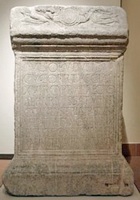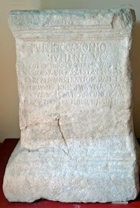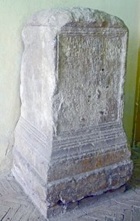Umbria in the 4th Century: Latin Inscriptions
Home Cities History Art Hagiography Contact
Umbria in the 4th Century: Main page Inscriptions Early Christianity


Umbria in the 4th Century: Latin Inscriptions
Home Cities History Art Hagiography Contact
Umbria in the 4th Century: Main page Inscriptions Early Christianity
Province of Tuscia et Umbria
Until the reforms of the Emperor Diocletian, the cities of Italy enjoyed a large measure of autonomy under the direct auspices of the imperial authorities in Rome. However, this situation became increasingly unsustainable as the administrative centre of the Empire moved away from Rome. As part of a wide-reaching reform of the provinces, Diocletian apparently created new provinces in Italy itself. These were first recorded in the so-called “Verona List’, which, according to Timothy Barnes (referenced below, 1982, at p. 205) represented the western provinces as they were in the period 303-14 AD: the list (set out by Timothy Barnes, referenced below, 1982, at p. 208) named eight Italian provinces. He also summarised this development (at pp. 218-9), pointing out that the provinces must have been created between:
-290 AD, when Aelius Helvius Dionysius was ‘corrector utriuque Italiae’ (governor of northern and peninsular Italy); and
-ca. 294 AD, when Titus Flavius Postumius Titianus was ‘corrector Campaniae’ (governor of the Italian Province of Campania)
Among these Italian eight provinces was the Province of Tuscia et Umbria, which presumably absorbed the cities of what had been:
✴the Augustan region of Etruria; and
✴the part of Augustan region of Umbria that lay to the west of the Apennines.
The epigraphic record includes a series of governors of this province in the period from ca. 310 AD until at least 366 AD (when the title apparently changed from Correctore or Consulare).
According to Timothy Barnes (referenced below, 2012, at pp. 92-3, following Constantine Zuckerman, also referenced below), the provinces were grouped into twelve diocese by Constantine and Licinius in 313 AD. The provincial governors were now hierarchically ranked:
✴The Proconsuls of Africa Proconsularis and Asia, together with the Urban Prefect of Rome, reported directly to the imperial authorities.
✴The other provinces were grouped into (originally twelve) dioceses, and their respective provincial governors (entitled Correctores or Consulares in other important provinces and Praesides elsewhere) reported to Rome via a diocesan official entitled “Vicarius”.
Governors of Tuscia et Umbria
The names of individuals who held this rank are mostly known from the inscribed bases of statues that were dedicated to them:
✴Three Correctores of Tuscia et Umbria are known from inscriptions in Umbria (all described below), from:
-Interamna Nahars/Terni;
-Spoletium/ Spoleto; and
-Narnia/ Narni).
✴Other men who are known to have held the post included:
•Correctores
-Caius Vettius Cossinius Rufinus: His early career is known from the base of a statue of him erected by the council and people of Atina in Campania (CIL X 5061; LSA-1978). The inscription recorded that the councillors and people of Atina were commemorating a most worthy patron, “who during his governorship (correctura), which took place during the ferocious tyranny [i.e. under Maxentius], did not suffer any harm”. He had already held the posts of proconsul of the Province of Achaia. corrector Venetiae and and corrector Tusciae et Umbriae, so all four posts must have pre-dated Constantine’s defeat of Maxentius in 312 AD: Timothy Barnes (referenced below, 1982, at p. 162) dated his tenure in Tuscia et Umbria to ca. 310 AD, and he is certainly the earliest holder of this post for whom we have evidence. Under Constantine, he became Urban Prefect (315-6 AD) and consul in 316 AD. He held three priestly offices in Rome: Pontifex dei Solis (priest of the cult of Sol Invictus, a role that had apparently been “drawn by lot”); augur; and member of the College of the Salii Palatini (a cult devoted to Mars).
-Caius Iulius Rufinianus Ablabius Tatianus: was subsequently governor of Campania; the council and people of Abellinum there erected a statue of him (CIL X 1125; LSA-1860). Timothy Barnes (referenced below, 1982, at p. 162) dated his tenure in Tuscia et Umbria to sometime in the period ca. 326 - 40 AD.
-Vettius Agorius Praetextatus: belonged to one of the last great senatorial families that was still performing pagan rites in Rome in the 4th century. His governorships were, successively: corrector of Tuscia et Umbria; consularis of Lusitania; and proconsul of Achaia. He was then urban prefect of Rome in 367-8 AD and praetorian prefect in 384 AD. He was designated consul for the 385 AD but died before he could take up this office. (See CIL VI 1778; LSA-1473 and CIL VI 31929).
-Iulius Festus Hymetius went on to be governor of Africa in 366-8. He was exiled by the Emperor Valentinian but was rehabilitated after this emperor’s death in 375. The people of the province of Africa erected gilded statues of him in Rome and Carthage in 376-8 (CIL VI 1736; LSA 1439).
•Consolares
-Lucilius Constantius: the council and people of Luni erected a statue of him (CIL XI 6958; LSA-1620).
-Betitius Perpetuus Arzygius: the people of the province of Tuscia et Umbria erected a statue of him in Rome (CIL VI 1702; LSA 1406).
Inscribed base of a statue from Terni (before 344 AD)

Iulio Eubulidae
c(larissimo) v(iro)
corr(ectori) Tusciae [et Umbria]
Xviro, praefecto
aerariis Saturni
ob inlustria ipsius/ merita et amorem iux/ta cives
ordo inte/ramnatium patrono
The lower part of the inscription records that the councillors of Interamna had erected this statue (now lost) to its patron for his distinguished services and love for the city. The upper part outlines his career:
Corrector of the province of Tuscia [and Umbria]
a member of a college of 10 priests
prefect of the treasury of Saturn
The date of the dedication is uncertain, but it must pre-date 344 AD, when Eubulidas was appointed vicar of Africa (an important appointment that would have been recorded in inscriptions of this kind).
This inscription is now in the Museo Archeologico, Terni.
Inscribed base of a statue from Spoleto (346 AD)
This inscription (CIL VI 1768, LSA 1467), which was discovered in Rome, reads:
Asterii
L(ucio) Turcio Aproniano, v(iro) c(larissimo)
filio L(uci) Turci Aproniani, v(iri) c(larissimi)
praefecti urbi, nepoti /L(uci) Turci Secundi, c(larissimi) v(iri) consulis
quaestori, praetori, quindecem/viro sacris faciundis
correc/tori Tusciae et Umbriae omni / virtute praestanti.
statuam /ex aere, ordo Spoletinorum
ad memoriam perpetui nominis / conlocavit
curantibus Flavio Spe, v(iro) p(erfectissimo) et Codonio Tauro Iun(iore)
post Amanti et Albini cons(ulatum)
This commemorates Lucius Turcius Apronianus, signo Asterius, whose father (also Lucius Turcius Apronianus) had been Prefect of Rome in 339 AD and whose grandfather Lucius Turcius Secundus had been a Suffect Consul in 310 AD. He was probably the brother of Lucius Turcius Secundus Apronianus, signo Asterius, corrector Flaminiae et Piceni in the 340s AD AD.
The Lucius Turcius Apronianus of this inscription had been Corrector of Tuscia et Umbria in 342 AD. (The Emperor Julian the Apostate appointed him as Prefect of Rome in 363-4) The council of Spoletium erected this statue of him in the year following the consulate of Flavius Amantius and Marcus Nummius Albinus (i.e. in 346 AD). The base is now in the Musei Capitolini, Rome.
A similar inscribed base (CIL VI 1769, now lost) was erected to him, probably at the same place and certainly at the same date, by the council and people of the city of Luca. The Praetor Etruriae XV honoured in the inscription (CIL XI 5170; EDR 125668; 4th century AD) from Bettona probably belonged to this family.
Inscribed Base of a Statue from Narni (before 366 AD)

[Iuli]anii / P(ublio) Publilio Caeionio / Iuliano,
v(iro) c(larissimo)
correctori Tusciae et Umbriae
ob insigni eius gesta et inlus/tre administrationis meritum
ordo Narniensium una cum civibus statuam conlocave/runt
patrono dignissimo
It records the dedication of a statue (now lost) of Publius Publilius Ceionius Iulianus, of clarissimus rank, who was governor (corrector) of the Province of Tuscia et Umbria. The last lines of the inscription record that the statue had been erected by the city council and the people of Narnia to reward the remarkable achievements and distinguished service of their most worthy patron.
The inscription is now in the Museo della Città e del Territorio, Narni.
Coronatus Tuscia et Umbria
There are two known inscriptions, both from Umbria (from Hispellum/ Spello and Carsulae - see below) that record a ‘coronatus’ of the province of Tuscia et Umbria. This was a civic role, the holder of which would have presided over provincial assemblies.
Inscribed Base of a Statue from Spello (ca. 335 AD)

The inscription reads:
C(aio) Matrinio Aurellio
C(ai) f(ilio) Lem(onia) Antonino v(iro) p(erfectissimo)
coronato Tusc(iae) et Umb(riae)
pont(ifici) gentis Flaviae
abundantissimi muneris sed et
praecipuae laetitiae theatralis editori
aedili quaestori duumviro
iterum q(uin)q(uennali) i(ure) d(icundo) huius splendidissimae
coloniae curatori r(ei) p(ublicae) eiusdem
colon(iae) et primo principali ob meritum
benevolentiae eius erga se
[ple]bs omnis urbana Flaviae
Constantis patrono/ dignissimo
The following translation is essentially from the website “Last Statues of Antiquity” (link above), published by the University of Oxford:
To Caius Matrinius Aurelius Antoninus, son of Caius, of the Lemonia tribe, of perfectissimus rank:
✴‘coronatus’ of the province of Tuscia et Umbria;
✴priest of the family of the Flavian dynasty [a quasi-religious role in which he would have officiated the imperial cult that was centred on the new temple that had been sanctioned in the Rescript of Constantine];
✴sponsor of most abundant spectacles and of extraordinary rejoicing in the theatre [which must have included the games held at Hispellum after the issue of the Rescript of Constantine];
✴aedile; quaestor; twice ‘duumviro quinquennali iure dicundo’ [three civic magistracies] of this most splendid city;
✴curator of the city and first notable.
The last line records that the people of the city set up the statue on account of the kindness towards it of this most worthy patron.
Inscribed Base of a Statue from Carsulae (4th century AD)
Another inscription commemorating a ‘coronatus’ of the province of Tuscia et Umbria, this time from Carsulae, was mentioned but not described by Umberto Ciotti in 1977 (on p22 and p24 of “San Gemini e Carsulae”). The surviving fragments have recently been tracked down and the inscription has finally been published (E. Roscini and E. Zuddas, “Il Coronatus Ritrovato”, Epigraphica (2014) pp 231-64). The main part (on the two largest fragments, reads:
[- - -]onato splend[ ... ]
[- - -] nobili prosapiaq(ue)
[- - -]to patrono [ ... ]
[- - - coro]nato Tusciae et Um[b(riae)]
[- - -]mni umore profuso
[- - - ci]vium defension(...) [ ... ]
[ ------]
This seems to preserve the cognomen Donato (line 1) and to refer to his noble family (line 2). Lines 3 and 4 identify him as:
✴[....]to, which the authors complete as “omnibus honoribus functo”, a phrase used at this time to summarise the civic career of a man who had held all the important offices in the government of a municipality;
✴ a patron, presumably of Carsulae; and
✴‘coronatus’ of the province of Tuscia et Umbria.
Read more:
C. Zuckerman, "Sur la Liste de Vérone et la Province de Grande Arménie,: a Division de l' Empire et la Date de Création des Diocèces", in
“Mélanges Gilbert Dagron”, (2002) Paris, pp. 617–637
T. Barnes, “Constantine: Dynasty, Religion and Power in the Later Roman Empire”, (2011) Chichester
T. Barnes, “The New Empire of Diocletian and Constantine”, (1982) Cambridge (MA)
J. Matthews, “Continuity in a Roman Family: the Rufii Festi of Volsinii”, Historia: Zeitschrift fur Alte Geschichte, 16 (1967) 484-509
Return to the History Index